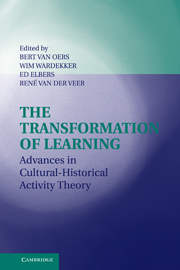Book contents
- Frontmatter
- Contents
- List of Contributors
- Preface
- INTRODUCTION
- SECTION ONE TENETS OF ACTIVITY THEORY
- SECTION TWO IDENTITY, DIVERSITY, AND INCLUSION
- Introduction to Section Two: Identity, Diversity, and Inclusion
- 9 Identity Shifts in Informal Learning Trajectories
- 10 No Human Being Is Illegal: Counteridentities in a Community of Undocumented Mexican Immigrants and Children
- 11 Cultural Identity and Emigration: A Study of the Construction of Discourse about Identity from Historical-Cultural Psychology
- 12 Diversity in the Construction of Modes of Collaboration in Multiethnic Classrooms: Continuity and Discontinuity of Cultural Scripts
- 13 “Discourse” in Cultural-Historical Perspective: Critical Discourse Analysis, CHAT, and the Study of Social Change
- 14 Reason and Dialogue in Education
- SECTION THREE DYNAMICS OF ACTIVITY AND THE VARIATIONS OF LEARNING
- Index
- References
11 - Cultural Identity and Emigration: A Study of the Construction of Discourse about Identity from Historical-Cultural Psychology
Published online by Cambridge University Press: 25 August 2009
- Frontmatter
- Contents
- List of Contributors
- Preface
- INTRODUCTION
- SECTION ONE TENETS OF ACTIVITY THEORY
- SECTION TWO IDENTITY, DIVERSITY, AND INCLUSION
- Introduction to Section Two: Identity, Diversity, and Inclusion
- 9 Identity Shifts in Informal Learning Trajectories
- 10 No Human Being Is Illegal: Counteridentities in a Community of Undocumented Mexican Immigrants and Children
- 11 Cultural Identity and Emigration: A Study of the Construction of Discourse about Identity from Historical-Cultural Psychology
- 12 Diversity in the Construction of Modes of Collaboration in Multiethnic Classrooms: Continuity and Discontinuity of Cultural Scripts
- 13 “Discourse” in Cultural-Historical Perspective: Critical Discourse Analysis, CHAT, and the Study of Social Change
- 14 Reason and Dialogue in Education
- SECTION THREE DYNAMICS OF ACTIVITY AND THE VARIATIONS OF LEARNING
- Index
- References
Summary
In this chapter we try to offer both a conceptual and a methodological proposal for the study of cultural identity from historical-cultural psychology. First, we develop a conceptual framework in which we define acts of identification as a suitable unit of analysis for cultural identity. Acts of identification dynamically integrate social and individual components, both of which are necessary in the explanation of cultural identity. Second, we present an empirical research project based on these conceptual ideas. In this project we analyze the acts of identification performed by various groups of Andalusian people from southern Spain that differ in their experience of migration. We study how this experience of “otherness” shapes their acts of identification when talking about Andalusia as a cultural group.
CONCEPTUAL AND METHODOLOGICAL APPROACHES
The study of cultural identity connects concepts that concern the individual and the social planes in psychological functions. The first problem in the study of cultural identity is whether it should be attributed to the individual or to the group (Ferdman, 1990). Different answers have been given to this question. For instance, some works in the social sciences attribute the concept of identity to the group and consider that the individual assumes this cultural identity as a member of that group (Ball, Giles, & Hewstone, 1984). When talking about a collective identity in a given social group, these scholars search for a set of constant traits possessed by all individuals in the group.
- Type
- Chapter
- Information
- The Transformation of LearningAdvances in Cultural-Historical Activity Theory, pp. 201 - 218Publisher: Cambridge University PressPrint publication year: 2008



